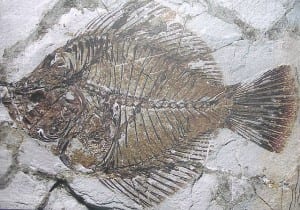Specimen of the Week 216: European Plaice
By Dean W Veall, on 30 November 2015
Hello dear Specimen of the Week readers, Dean Veall here. This week I shall be bringing you a very fishy (again) Specimen of the Week, how can I possibly top the three toothed pufferfish you may be asking yourself? Well, I believe I have for two very good reasons. Firstly the fish I have chosen is one of the asymmetrical marvels of the natural world. Secondly, has one of the most curmudgeonly comical faces of all animals (I challenge you to find me an animal that beats this specimen). And finally, has recently featured in the events that have accompained our Glass Delusions exhibition. This week’s Specimen of the Week is…..
**European plaice (Pleuronectes platessa)**
1). Flatfish and Co.
Our plaice is one of four different species of Pleuronectes that belong to the order of flatfish known as Pleuronectiforme, an order that comprises of over 700 different species of fish. This group of fish also happens to include some of the most delicious fish we are familiar with such as soles and turbot. There are two characteristics that this species is defined by and which we know (and love) about our more familiar European plaice, it’s flattened body and eyes that lie to one side of it’s head. Our plaice is what is known as a dextral or right eyed fish (more on that later). There are two other characteristics of this group and you can just about see from our specimen and are adaptations for seabed dwelling, the eyes protrude from the head making it easier to spot prey whilst lying amongst the sediment and also the dorsal fin has extended onto the head.
2). Laying on the Floor of the Bed
During the day our European plaice is likely to be found buried in the muddy or sandy sediment staying absolutely stationary as it is predominantly nocturnal. At night and free from possible predation, it ventures out from beneath the sand to feed on polychete worms, bi-valves and crustaceans. In life, as is the case with our specimen, the European plaice has a dark brown/greenish skin, with irregulalry distributed orange spots which when combined with it’s burrowing habit, help it camoflague from potential predators.

“Pleuronectes platessa” by © Hans Hillewaert. Licensed under CC BY-SA 4.0 via Commons – https://commons.wikimedia.org/wiki/File:Pleuronectes_platessa.jpg#/media/File:Pleuronectes_platessa.jpg
3). The Fish Debates
A humble, common fish like this European plaice might not seem a controverisal figure, but it was until 2008. Opponents of evolution by natural selection have attacked the theory because of a lack of intermediary forms of various animals and plants arguing that species can arise instanteously as a result of major mutations rather than a gradual process. The plaice and other flatfish have been the poster fish for this campaign. This is mostly because there appears to be very little evidence of tranisitional species in the fossil record that would link these living asymmetrical flatfish with their symmetrical relatives. However, in 2008 Matt Friedman from the University of Chicago and based at the Field Museum published a paper in Nature that two genera of extinct spiny finned fish Amphistium and Heteronectes dating back 56 million years ago exhibited the beginnings of asymmetry that characterise the living species of flatfish. Although not a complete migration of the orbital regions to one side of the skull, analysis of the fossils revealed a strong asymmetry in the this region, leading Friedman to conclude they exhibit intermediary characteristics between living flatfish and their symmetrical realtives.

“Amphistium” by Totodu74 – Own work. Licensed under Public Domain via Commons – https://commons.wikimedia.org/wiki/File:Amphistium.JPG#/media/File:Amphistium.JPG
4). Righty or Lefty?
No, not a political affliation* of European plaice, but the location of the eyes. As a rule it would appear species have either eyes on the right-side (dextral) like our plaice or eyes on the left-side (sinistral) such as the tonguefishes. The one exception appears to be the spiny turbots which have equal number of left and right-sided individuals.
*(In case you wanted to know, I imagine our plaice is a lefty Guardian reading type, being in a museum and all)
5). How to Rub a Fish
One of the main reasons I chose this specimen because I am very proud of this piece of work:
This is a rubbing of a plaice (not our specimen) but one which was sourced by artist and radical and innovative fishmonger Sam Curtis. Together with our brilliant Artist in Residence, Eleanor Morgan, I programmed a fish rubbing event at the Sluice_ Art Fair a few weeks ago that was part of our Glass Delusions events programme.
Eleanor, a print-maker, has developed a technique that features in her exhibition of guerilla printing techniques as a way to capture, in ink, the three dimensional. So how do you rub a fish? Well, here’s the plug, you can join us on Thursday 10th December for our masterclass, or pop in to the Museum to see Eleanor’s Glass Delusions (closing 19th December) and purchase your copy of the guide for just £3.
Dean Veall is Learning and Access Officer at the Grant Musuem of Zoology.
 Close
Close





